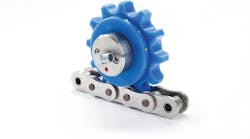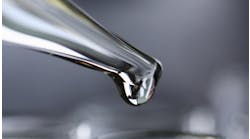Food-grade lubricants are divided into two classes: synthetic and mineral oil-based with the difference between the two contained mostly in the raw material.To learn more about the classifications as well as other terms often used with food-grade lubricants, download this handy guide.
Put the right amount of the right kind of lubricant in the right place. Simple, right?
But there are very few simple aspects to running a food or beverage plant, and lubrication is no exception. Lubricant types and application methods present an array of choices; making the right choices helps keep equipment running properly with minimal risk of product contamination.
The most basic choice is whether, and how widely, to use food-grade lubricants, which are designed to be non-toxic in trace amounts. Known as H1 lubricants, these are generally more expensive than non-food-grade (H2) lubricants, and often degrade faster. This tempts maintenance people to lubricate with H2 oils and greases.
But the toxicity of H2 products creates a food safety issue, which is, or should be, the overriding concern.
“You see very few large manufacturers who take the risk of using non-food-grade lubricants,” says David Turner, senior technical services representative with Clarion Lubricants, a brand of Citgo. “It only takes one incident where food gets contaminated and you have to destroy a whole bunch of food to see the payoff of using a food-grade lubricant.”
But many companies are still not familiar with the benefits of H1 lubricants, adds Chris Kniestedt, industrial lubrication specialist for the San Francisco division of Motion Industries.
“One of our main challenges is to remember that, in the big picture, food-grade H1 lubricant use has not been a prominent part of industry for a long period of time,” Kniestedt says. “I see this on a regular basis – companies and specifically their maintenance personnel are still learning about these lubricants.”
Some maintenance people try to split the difference by making a distinction between equipment above and below the conveyor line. H2 non-food-grade lubricants, according to this thinking, are fine below the line. But Kniestedt considers this a false economy.
Using H2 products below the conveyor line still “means that you have a lubricant within close proximity to and in the presence of a food product. This is a prescription for disaster,” he says. “Even if the [lubricants] seem to be down and away [from the conveyor], I still believe there is the chance of transference of an H2-level product upward – causing it to have contact with product.”
Pure synthetics
One way to resolve the performance issue is to use synthetic food-grade lubricants. Regular H1 lubricants are made from mineral oil, which derives purely from petroleum. Synthetics use non-petroleum-based chemicals, most often esters and olefins (sometimes blended with petroleum components). In practical terms, synthetics are more expensive than mineral oil lubricants, but they last longer and perform better, especially in extreme environments.
“One of the largest trends is the increased use of synthetic food grade H1 products,” Kniestedt says. “While the price is higher, customers are beginning to see the tremendous value of these lubricants. They pay for themselves very quickly because synthetics provide a service life up to four times that of conventional or mineral lubricants.”
Another big benefits of synthetic lubricants is purity. Mineral oils, even highly refined ones, can have impurities that create instability and lower lubricity. Because synthetics are entirely manmade, it’s easier to control their formulation and refining to ensure purity, Kniestedt says. Synthetics can handle very high or very low temperatures better than mineral-oil H1 lubricants; they have higher film strength, which allows for higher load-carrying capacity; and they can run longer before their viscosity starts to break down.
Applied science
The best lubrication in the world isn’t any good unless it’s applied properly. That means timely application in the right amount. Too little lubricant obviously won’t do the job; too much presents a danger of contamination.
“They don’t want the oil that they’re using to oil the chain, for example, to end up dripping on the food or the packaging. What we advise is to use minimal lubrication,” says Kurt Rommelfaenger, sales and marketing manager for Oil-Rite Corp.
Fixed, permanent stations are often used in spots where a steady supply of lubrication is required, like a bearing housing. These can be as simple as a bulb oiler or other reservoir that feeds equipment by gravity. This equipment, which has been around since the 1930s, sometimes features a small lower reservoir that feeds the device being lubricated and shows its lubricant level; a larger upper reservoir replenishes it when the level drops, allowing more lubricant to flow into the device.
Other devices lubricate equipment more actively. Oil-Rite markets the PurgeX, a small piston pump that periodically applies lubricant as needed to any equipment or machine part. It has connections for lubricant, fed from a reservoir, and compressed air to drive a piston. At only 4 in. tall, it can be attached almost anywhere; a spray version features a semi-rigid tube, just over a quarter-inch in diameter, that can be snaked through a machine to deliver lubricant where needed.
The Rotalube system from Timken uses a sprocket wheel to apply oil to a conveyor chain.
The PurgeX can be controlled through a dedicated switch or through existing equipment controls like PLCs, with cycles ranging from once per second to a couple of times per hour. It delivers a maximum of 0.19ml of lubricant per cycle. A smaller version, the Ultra-Micro PurgeX, delivers one-tenth of that.
An automatic lubrication device especially for chain conveyors comes from Timken, a supplier of material handling and mechanical power transmission equipment. The Rotalube is a sprocket-shaped applicator, fed oil from an application system, that fits onto single-chain conveyors. It automatically delivers a predetermined dose of lubricant through a series of 24 small injector holes precisely onto the chain’s links and pins, ensuring the chain is constantly oiled during operation while avoiding over-lubrication. Lubricant emerges only from the holes that are aligned with the chain at any given moment, making for precise application.
“Unlike conventional drip or spit-feed systems, which constantly are applying oil, we’re applying it on a [customized] basis, and we can actually stop the application of oil in the system program,” says Trevor Roberts, product manager for the Groeneveld UK unit of Timken, which markets the Rotalube. “Although the sprocket is always turning, the oil is only delivered at the agreed time intervals.”
Lubriplate offers color-coding systems that ensure replenishment with the right lubricant.
The Rotalube can either use self-contained, dedicated controls or be tied into an existing PLC. It is being used by a UK chocolate manufacturer that had experienced problems with dust adhering to conveyor chains; the Rotalube reduces the oil coating on the chain so much, while still providing the necessary lubrication, that the chocolate dust doesn’t stick.
Lubing by color
A wide variety of plant equipment needs to be lubricated, which means that lubricants have to vary, too. Making sure the right lubricant gets used in the right place is vital, especially at points where it is continually applied.
Some suppliers offer color-coding systems that match tags to lubricant containers. Lubriplate Lubricants Co. offers, as part of its free Extra Services Package, visits by technicians who will survey all lubrication points and generate color-coded lube charts with matching signs and plastic tags that can be affixed to equipment or reservoirs. The tags can be made with an additive that will set off metal detectors if pieces of them should happen to get into a product or package.
“Hydraulic systems, gear reducers, blowers and all other reservoirs containing oil benefit from having lubricant identification tags,” says Don Wrocklage, Lubriplate’s national accounts manager. Tags ensure that the right lubricant will get selected immediately, making replacement more efficient.
Lubrication isn’t as simple as just squeezing an oil can. But using the right lubricants in the right way can lead to a well-oiled operation – literally and in the larger sense.


